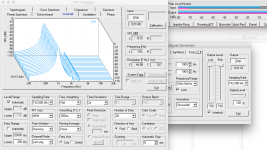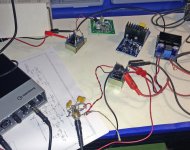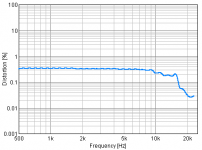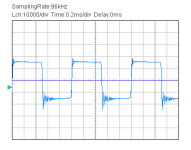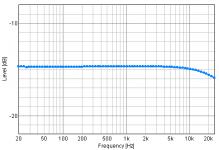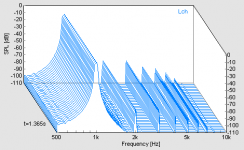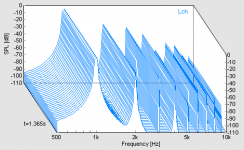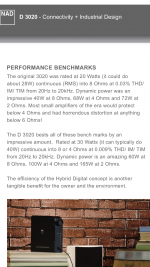Just curious, does anyone actually measure distortion on diy or purchased Class-D amps?
I am seeing some unusual harmonic spectra in the audio band. i.e. 3rd,4th,5th that was not expected at high power levels.
This is not seen at the 1W 1khz data sheet type testing.
bruce
I am seeing some unusual harmonic spectra in the audio band. i.e. 3rd,4th,5th that was not expected at high power levels.
This is not seen at the 1W 1khz data sheet type testing.
bruce
I'd definitely like to, but it looks like i need to buy a few things to make totally sure that I don't fry my sound card.
I am seeing some unusual harmonic spectra in the audio band. i.e. 3rd,4th,5th that was not expected at high power levels.
This is not seen at the 1W 1khz data sheet type testing.
bruce
Why they are not expected? I'd rather say they are typical. This is the nature of distortion.
At low level typically 2nd or 3rd harmonic dominates, this is natural also (there are a few exceptions).
What are folks using for sound cards? Are there any lower cost USB <$50 ones that are quiet and low THD enough to work?
Distortion measurements/graphs scare me :/ many times i have used amps that my ears are happy with then at a later date seen measured distortion levels and thought OMG ! my speakers are being subjected to THAT ! ! ! sometimes it's preferable to live in ignorance 🙂
I googled around to see what the typical specs ,for example rogue audio hybrid D is 1% at rated power.
JL's full range automotive amp is same 1%.
So looks like that is the benchmark.
-
JL's full range automotive amp is same 1%.
So looks like that is the benchmark.
-
TA2021, 6Vrms into 4.7ohm

OMG that would be rough to listen to for extended time. I would go psyacoustic postal.
it's not really the THD , it's the particular higher harmonic content but there is a solution.
-
Why they are not expected? I'd rather say they are typical.
Not in my experience with non-Class D amps. Those high level harmonics aren't usually present below the onset of clipping. Ironically it reminds me of a Mullard 3-3 tube amp I built ages ago: EL88 + EL86 It didn't sound very good and is long dismantled.
Not in my experience with non-Class D amps. Those high level harmonics aren't usually present below the onset of clipping. Ironically it reminds me of a Mullard 3-3 tube amp I built ages ago: EL88 + EL86 It didn't sound very good and is long dismantled.
ya pentodes are ugly, i gave them a shot in hybrid ckt , triodes are sweeter for sure.
I googled around to see what the typical specs ,for example rogue audio hybrid D is 1% at rated power.
JL's full range automotive amp is same 1%.
So looks like that is the benchmark.
-
Over in the Solid State Forum, typical DIY class AB amps are in the 0.001% to 0.01% THD at 1kHz and close to full power (before clipping). Depending on number of output transistors this is about 30w (for one pair) to 75w (two pair). Really special class AB amps where people work at getting the THD low are in the "immeasurable" low distortion range of 0.00007% THD (tomchr's mod86 amp for example), or the extremeA (Sassen and Putzeys),
http://www.diyaudio.com/forums/solid-state/96853-extrema-class-strikes-back.html
http://www.diyaudio.com/forums/chip-amps/267802-modulus-86-build-thread.html
1% THD is actually quite bad - that's -40dB and basically at the limit of audibility but most of my speakers are capable of between -50dB and -55dB HD over various frequencies, so I would want an amp that is less so it doesn't contribute.
Also, it's important to look at the spectrum and not just a THD number. The odd harmonics are much more egregious so need to be even lower than even harmonics.
I am still trying to build a setup to measure HD in a resistive dummy load, but for now, I look at the HD spectrum on my reference speaker to make sure it is not any higher than the native capability of the speaker.
Here is an example of a very simple 8 transistor 50w MOSFET class AB amp and it's clean (no-contribution) to the speaker measured HD plot.
FX8 Bimo Mod:
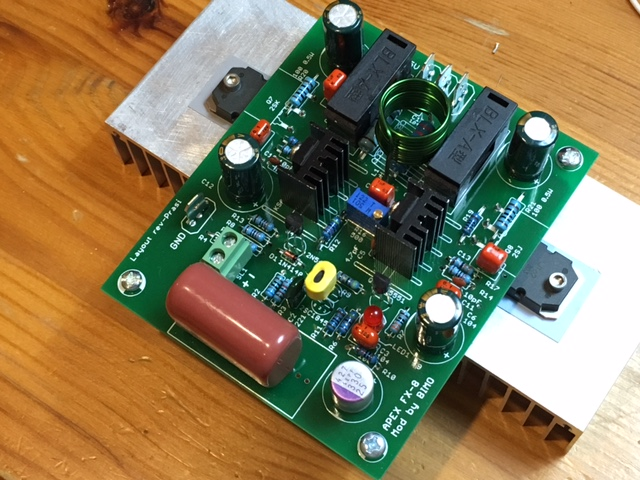
HD spectrum as measured on 10F/8424 and RS225-8 FAST 2-way with transient perfect passive XO:
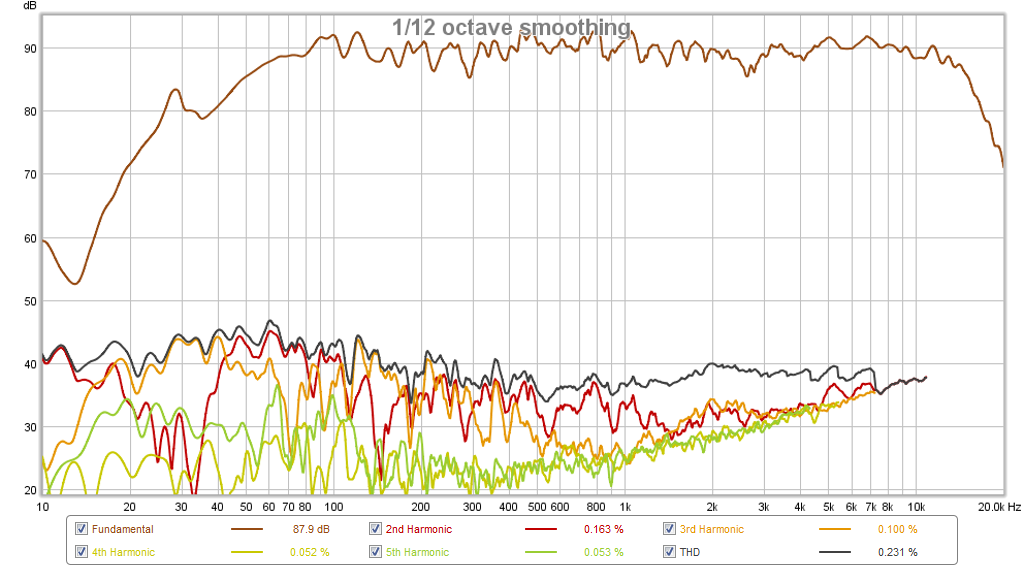
Note that this is a sealed 24L woofer, yet the class AB amp has enough authority to get 51Hz F3 for the bass. I could never get this kind of extension with a TPA311x class D.
More info here:
http://www.diyaudio.com/forums/solid-state/164093-100w-ultimate-fidelity-amplifier-775.html
here are some plots I just took on a YJ half-bridge board. I'm liking the waveform of the clip. It looks musical.
These are all into 8 ohm. +-34V, protections disabled and gain of 4.
Still very interested in pursuing to the bitter end. Just got in some LJM modules so anxious to try.
Bought some certified irs2092 from Mouser and will replace the shipped ICs just for grins.
The TPA3118 PBTL shipment should be here in a few days.
Looking very closely at the scope view, I can of course the the switching. I'm wondering if the THD and FFT engines are analyzing these minute artifacts and integrating into calculation.
The file names are descriptions.
-
These are all into 8 ohm. +-34V, protections disabled and gain of 4.
Still very interested in pursuing to the bitter end. Just got in some LJM modules so anxious to try.
Bought some certified irs2092 from Mouser and will replace the shipped ICs just for grins.
The TPA3118 PBTL shipment should be here in a few days.
Looking very closely at the scope view, I can of course the the switching. I'm wondering if the THD and FFT engines are analyzing these minute artifacts and integrating into calculation.
The file names are descriptions.
-
Attachments
What are folks using for sound cards? Are there any lower cost USB <$50 ones that are quiet and low THD enough to work?
To a zeroth order to make sure that your amplifier is working well, absolutely. Even if they're -90 dB (and most should get there!), that's going to get you pretty far.
To a zeroth order to make sure that your amplifier is working well, absolutely. Even if they're -90 dB (and most should get there!), that's going to get you pretty far.
my usb sound card was under $100. You need balanced line level inputs for BTL.
the macbookpro sound card has better specs than Stienberg but I dont want to damage.
Measuring a class D amp with a sound card (or other digitized method) can be tricky. Class D amps put out significant amplitude supersonic output (usually in the 200kHz to 600kHz range) due to switching frequency feedthrough. It's not a 'distortion' the way most think of distortion, but more like a spurious tone. Not likely a problem for listening, since no tweeter is going to be able to reproduce it at even measurable levels.
But connect the amp output to a soundcard, and you'll subject the soundcard to that highish supersonic output. The card has anti-aliasing filters, but not enough to deal with hundreds of millivolt signal levels like from a class D amp. What happens is that aliasing occurs which folds the energy into the display to make it look like audio band tones in odd places (they aren't really there, it's a result of violating the bandlimiting requirement needed for digitized audio systems). Systems like AudioPrecision have extra lowpass filtering available that can be inserted to cut the supersonic junk down to manageable size when measuring class D amps.
Measuring the speaker output (probably) won't be subject to the antialiasing. But if you want to measure the amp's output directly, you should probably make up a high-rejection all-pole filter/attenuator to put between the amp and the sound card.
But connect the amp output to a soundcard, and you'll subject the soundcard to that highish supersonic output. The card has anti-aliasing filters, but not enough to deal with hundreds of millivolt signal levels like from a class D amp. What happens is that aliasing occurs which folds the energy into the display to make it look like audio band tones in odd places (they aren't really there, it's a result of violating the bandlimiting requirement needed for digitized audio systems). Systems like AudioPrecision have extra lowpass filtering available that can be inserted to cut the supersonic junk down to manageable size when measuring class D amps.
Measuring the speaker output (probably) won't be subject to the antialiasing. But if you want to measure the amp's output directly, you should probably make up a high-rejection all-pole filter/attenuator to put between the amp and the sound card.
Over in the Solid State Forum, typical DIY class AB amps are in the 0.001% to 0.01% THD at 1kHz and close to full power (before clipping). Depending on number of output transistors this is about 30w (for one pair) to 75w (two pair). Really special class AB amps where people work at getting the THD low are in the "immeasurable" low distortion range of 0.00007% THD (tomchr's mod86 amp for example), or the extremeA (Sassen and Putzeys),
http://www.diyaudio.com/forums/solid-state/96853-extrema-class-strikes-back.html
http://www.diyaudio.com/forums/chip-amps/267802-modulus-86-build-thread.html
1% THD is actually quite bad - that's -40dB and basically at the limit of audibility but most of my speakers are capable of between -50dB and -55dB HD over various frequencies, so I would want an amp that is less so it doesn't contribute.
Also, it's important to look at the spectrum and not just a THD number. The odd harmonics are much more egregious so need to be even lower than even harmonics.
I am still trying to build a setup to measure HD in a resistive dummy load, but for now, I look at the HD spectrum on my reference speaker to make sure it is not any higher than the native capability of the speaker.
Here is an example of a very simple 8 transistor 50w MOSFET class AB amp and it's clean (no-contribution) to the speaker measured HD plot.
FX8 Bimo Mod:

HD spectrum as measured on 10F/8424 and RS225-8 FAST 2-way with transient perfect passive XO:

Note that this is a sealed 24L woofer, yet the class AB amp has enough authority to get 51Hz F3 for the bass. I could never get this kind of extension with a TPA311x class D.
More info here:
http://www.diyaudio.com/forums/solid-state/164093-100w-ultimate-fidelity-amplifier-775.html
yes 1970-1980s some Sansui hifi had super marketing specs on engineering models but failed the critical 'audience' test.
The principals decided to focus on the best sounding, marketing had to tough it out.
-
THD measurements on TI's TPA3251. These are closed loop class D ICs, showing better than -80 dB at 25W out and -68 dB at 125W. Pretty sweet.
QuantAsylum Home Page
QuantAsylum Home Page
THD measurements on TI's TPA3251. These are closed loop class D ICs, showing better than -80 dB at 25W out and -68 dB at 125W. Pretty sweet.
QuantAsylum Home Page
i looked at it , impressive.
YJ is taking orders now $38.
my only issue is start-up sequence. Shure was burned a few years ago as was I.
had to dump big man hours , board was laid out when got the news input signals had to be not present during start-up.
yes have added a pic to do the management I had too many hours
- Status
- Not open for further replies.
- Home
- Amplifiers
- Class D
- Who actually measures distortion
